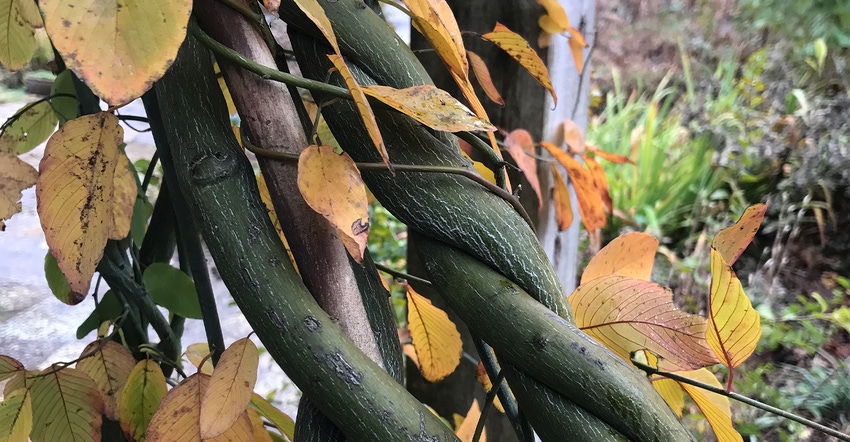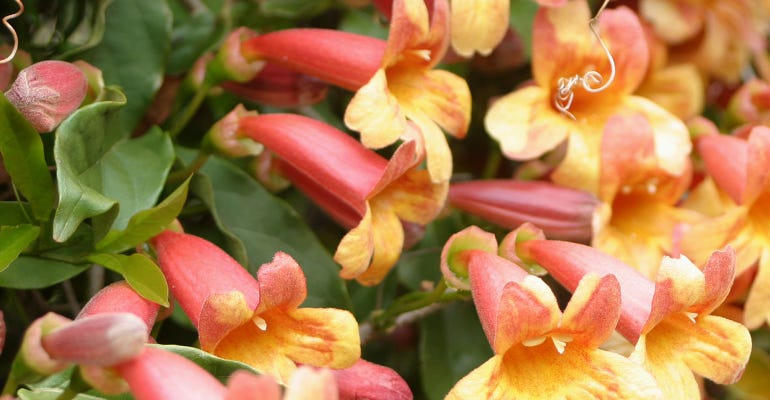November 22, 2019

In a winter garden, pruning woody plants is like completing a jigsaw puzzle or building a fire-breathing Lego ninja dragon ship from a heap of tiny plastic parts.
This time of year, branching is more obvious than in summer. Vine stems crisscross, rub on each other and meander out of bounds toward a house, street or walkway.
Often, a profusion of twigs and sprouts develop on plants growing in full sun, so a portion of them needs to be removed. This is referred to as corrective pruning. Another type of pruning — aesthetic pruning — is used to improve the beauty of the vine rambling over a lamppost, trellis or pergola.
Funny thing about woody vines: They are living things. Untended vines can grow to the size of small tree trunks, and like trees, they grow bigger and bigger each year — yet their support structures stay the same.
When they outgrow their structure, they need to be untangled and reduced in size. If not, they bulge at the top, envelop their structure or take over something else, and then they drape back down to the ground in an unsightly blob.
Pick the right size
The good news is that some native vines are less aggressive than others.
Native yellow, coral, and limber honeysuckle are small and are clump-forming woody vines. That makes them easier to care for than big vines.
Big native vines such as American wisteria, pipevine, wild grape lady’s eardrops, Virginia creeper, and trumpet creeper can be massive, growing 50 feet up a tree.

COLORFUL VINES: Many native vines are not just green. They have vibrant flowers that add to any farm’s landscape.

When the tree is growing amid a woodland where the vine and the tree exist in relative harmony, it is fine, but at the edge of the woods where there is much more sunlight, vines typically take over the tree. Cut the vines in favor of the tree.
Midsized vine species include bittersweet, supplejack, crossvine and Carolina moonseed. These typically grow 15 to 25 feet tall. Select these vines for landscaping projects because they can fully cover a good-size pergola yet can be easily managed with pruning.
Routine maintenance
Vines can quickly overgrow chain-link fence or wooden lattice. They need pruning every year or two to remove the oldest branches. Safety is key when pruning larger vines.
Some require scaffolding to work off, but a sturdy ladder is the next best thing.
Untangle the vines and lay them aside. Then cut back the oldest vines. Then shift focus to the young stems. Tie them up on a post to a structure so they can continue to climb.
Most of the vines mentioned above grow by twining around support structures much like how a black rat snake climbs a tree. The vines wrap around stems as they grow upward and likely will need to be tied up until they are tall enough to keep going.
Plants such as wild grape use spiraling tendrils that wrap around stems, clinging as they grow upward like clothespins on a line. Virginia creeper and crossvine have sticking pads at the tips of tendrils that are kind of like suction cups, growing straight up tree trunks, cliff faces, and even concrete buildings if the concrete is textured.
The only evergreen vine native to Missouri is crossvine, giving it a great advantage when trying to hide an ugly concrete or brick surface.
Woodbury is the curator of the Whitmire Wildflower Garden at Shaw Nature Reserve in Gray Summit, Mo., and an adviser to the Missouri Prairie Foundation’s Grow Native! program.
About the Author(s)
You May Also Like




